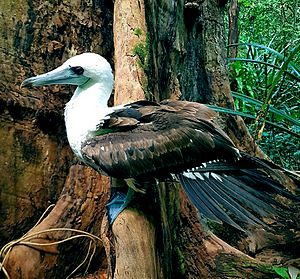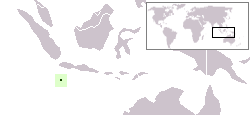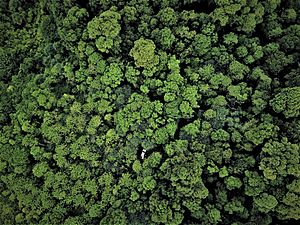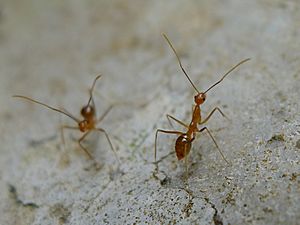Abbott's booby facts for kids
Quick facts for kids Abbott's booby |
|
|---|---|
 |
|
| Conservation status | |
| Scientific classification | |
| Genus: |
Papasula
|
| Species: |
abbotti
|
 |
|
| Christmas Island in green | |
| Synonyms | |
|
Sula abbotti (Ridgway, 1893) |
|
The Abbott's booby (Papasula abbotti) is a special type of seabird. It is part of the sulid family, which includes gannets and other boobies. This large booby is quite rare and is currently an endangered species. It is so unique that it has its own special group, called a monotypic genus. The bird was first found by a person named William Louis Abbott in 1892.
Abbott's booby only nests in a few places on Christmas Island. This island is an Australian territory in the eastern Indian Ocean. In the past, these birds lived in many more places. They have mostly white feathers with black markings. They are also very good at flying long distances.
These boobies look for food around Christmas Island. They often find food where cold, nutrient-rich water rises from the deep ocean. A pair of Abbott's boobies stays together for life. They raise one chick every two or three years. They build their nests high up in the tallest trees of the rainforest.
The number of Abbott's boobies is getting smaller. In the past, many of their forest homes were cut down. This happened to make way for phosphate mining. Some logging still happens today. The old logging still affects the birds. Another problem is the arrival of yellow crazy ants. These ants harm the forest where the boobies live. Even small changes to their home can greatly affect the birds. All the areas where they nest are now part of a national park.
Contents
What is Abbott's Booby?
How Was It Discovered?
The first Abbott's booby was found in 1892. It was collected from Assumption Island by an American naturalist named William Louis Abbott. Later, in 1893, a scientist named Robert Ridgway officially described the bird. In 1988, scientists decided this booby was so different that it needed its own special group.
Scientists believe Abbott's booby might be a very old type of seabird. It may have split off from other gannets and boobies a long time ago. Studies suggest it separated from other seabirds about 22 million years ago.
What Does It Look Like?
Abbott's booby is the largest of all booby species. It is built for flying very long distances. These birds can grow to about 80 cm (31 in) long, from their beak to their tail. They usually weigh around 1.5 kg (3.3 lb).
You can tell them apart from other seabirds by their black and white feathers. They have off-white bodies with black patches around their eyes. Their wings and tails are black, and they have black marks on their sides. Their feet are blue and webbed, with black tips. Male birds have light grey beaks with a black tip. Females have pink beaks with a black tip. Baby boobies have white fluffy feathers. They also have a cape of black feathers on their backs.
Young Abbott's boobies look similar to adult birds. This is different from other booby species, where young birds often look very different.
Where Do They Live?
Their Home on Christmas Island
Abbott's booby is the only booby species that lives in just one place. That place is Christmas Island. However, in the past, they lived in many parts of the Indian and Pacific Oceans. Scientists have found old bones that show they used to live in the South Pacific. There are also old reports of them nesting on the Mascarene Islands.
These birds build their nests in tall trees. They prefer the plateau forests in the middle and western parts of Christmas Island. They also nest in the upper terrace forests on the north coast. Nests are often found in trees on uneven ground. They usually build nests in Syzygium nervosum and Planchonella nitida trees. Sometimes, they use very tall Tristiropsis acutangula trees.
How Far Do They Travel for Food?
Abbott's boobies usually fly about 40–100 km (25–62 mi) from Christmas Island to find food. However, some birds are seen in Indonesia. A few have even been seen as far away as mainland Australia. One female bird was recently seen on Rota, an island in the Pacific. This shows they can travel very far.
How Many Are There?
Tracking the Population
The Abbott's booby population is the smallest of all sulid birds. It is also the most studied. In 1967, scientists estimated there were about 2,300 pairs of breeding birds. By 1983, this number had dropped to 1,900 pairs.
A big survey in 1991 found new nesting sites. This brought the estimate up to 2,500 breeding pairs. The total number of adult birds was thought to be around 6,000. A helicopter survey in 2002 counted 1,500 nest sites. The population stayed steady from 1991 to 2002.
Future Outlook
Scientists believe the population could drop by more than 80% in the next 120 years. This is because fewer young birds are surviving. Also, strong winds can harm the breeding birds. Because there are so few of them, and they have a small home, Abbott's boobies are at high risk of disappearing. This could happen if their habitat is disturbed even more.
How Do They Live?
Daily Life and Habits
Abbott's boobies are often seen alone. They are long-distance travelers. They can fly thousands of kilometers from Christmas Island. They make many different sounds and are very vocal.
Because they are large, they need a lot of clear space to take off. This is why they nest near the tops of tall trees. If a bird falls to the forest floor, it will likely starve. It needs to climb high enough to catch the wind and fly away. Adult birds rarely fight because of the risk of falling. Young birds must succeed on their first flight. If they fail, they usually do not survive.
What Do They Eat?
Adult boobies look for food at sea from October to April. They return to their nests if they have a chick to feed. They eat fish and squid in the ocean waters. They are thought to find food in an ocean upwelling near Java. This area is about 300 km (186 mi) northwest of Christmas Island. Parents feed their chicks by bringing up food from their stomachs. Both parents help feed the young birds.
How Do They Raise Their Young?
When boobies are ready to mate, they perform a special face-to-face display. Partners stay together for life. They also use the same nest site year after year. Nests are built high up in rainforest trees, about 10–40 m (33–131 ft) off the ground. They are usually at elevations of 150 m (492 ft) or higher.
Their breeding cycle lasts 15 to 18 months. They lay only one egg during each cycle. Successful pairs can nest every two years. However, they often take a year off between raising chicks. Most pairs only breed once every three years.
Mating usually happens in April. Eggs are laid between April and July. The egg is about 8% of the female's body weight. Both parents take turns sitting on the egg to keep it warm. They use their webbed feet, which get warm with blood. The eggs are incubated for about 56 days. This is 30 days longer than other sulid birds.
Chicks hatch from June to November. They take about 170 days to grow their feathers and learn to fly. They need another 200 days to become fully independent. Most chicks make their first flight in December or January. Young boobies become adults around eight years old. They can live for up to 40 years.
What Threats Do They Face?
Habitat Loss and Damage
Even a small decline in the quality of their home can greatly harm these birds. From 1965 to 1987, phosphate mining destroyed one-third of the Abbott's booby's nesting areas. The forest continues to get worse. The health of individual trees is decreasing.
Open spaces left by logging have increased wind in the forest canopy. This creates strong winds that can reach up to 300 m (984 ft) from the clearings. These winds cause fewer chicks to survive. Chicks can be blown out of their nests. They often do not survive their first flight. Adult birds are also at risk of falling to the ground when landing. This affects 36% of the current population.
New plants brought to the island are making it hard to fix the old mining sites. These plants could also spread into the main forest. Mining still happens. In 2007, mature forest was cleared for mining. A request to mine another large area was denied in 2007 but is still being discussed. The mining company is not allowed to clear primary forest. They need a permit to clear new growth.
Conservation Efforts
The Christmas Island National Park now protects all known Abbott's booby nest sites. The park was created in 1980 and has grown to cover 60% of the island. The bird population was watched closely from 1982 to 1993. In 1984, 20% of the mined areas near nesting sites were replanted with trees.
The Environment Australia Abbott's Booby Recovery Plan aims to regrow forests. It also works to stop the species from declining further. Forest repair has been tried in about 30% of old mining areas. The focus is on areas near the main forest. New trees there can act as a windbreak. Most of the planted trees are native species. Sometimes, non-native species are used if they do not harm the environment. The mining company helps pay for some of the forest regrowth. This is part of their agreement.
Threats from Invasive Species
An invasion of yellow crazy ants is a big problem for the booby population. These ants formed huge groups in the 1990s. They spread through 28% of the island's forest. Since 2000, efforts to control them have worked. They have been removed from large areas of forest. Their numbers were reduced by 95%. In 2005, they were only in 300 ha, and in much smaller numbers. However, their population has grown a bit since then.
The ants could eat baby birds or make parents leave their nests. This has not been seen yet. But they do harm the ecosystem. They kill red crabs. They also farm tiny insects that damage the trees where the boobies nest.
Other Dangers
Too much fishing and ocean pollution also threaten the boobies. The birds might be hunted or caught by accident in fishing nets. This could happen with Indonesian and Taiwanese fishing boats. However, this has not been officially recorded.
There have been talks about building a satellite launch pad on the island. But these plans are not happening right now.
In 1988, a strong storm destroyed one-third of all nests and young birds. Climate change is also a concern. Warmer ocean temperatures, changes in rainfall, and changes in weather patterns could further harm the population. Warmer seas reduce breeding success. This is because the best feeding areas are in cold water.
Abbott's booby is listed under CITES Appendix I. This means it is highly protected. It is also classified as endangered on the IUCN Red List. This list tracks species at risk. It is also endangered under Australian law. Many Abbott's boobies live in the National Park, and their nests are watched carefully.
See also
 In Spanish: Alcatraz de Abbott para niños
In Spanish: Alcatraz de Abbott para niños




